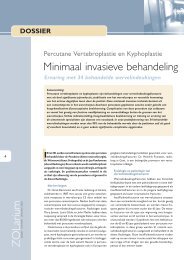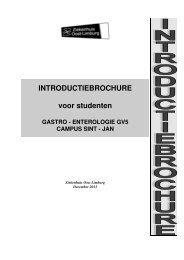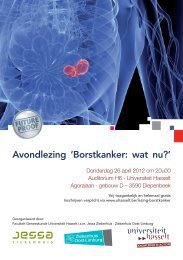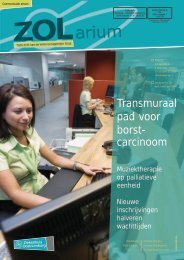ZOLarium copy.indd - Ziekenhuis Oost-Limburg
ZOLarium copy.indd - Ziekenhuis Oost-Limburg
ZOLarium copy.indd - Ziekenhuis Oost-Limburg
Create successful ePaper yourself
Turn your PDF publications into a flip-book with our unique Google optimized e-Paper software.
large enough to reconstruct wide rectangular wounds or extended<br />
spindleshaped defects. Especially in young patients, the volume of the<br />
gracilis muscle is much larger than expected from its descriptive but<br />
misleading name. Often it is precisely this patient population that gets<br />
involved in motorcycle accidents or traumas caused by contact sports.<br />
For the treatment of Gustilo type III open tibia fractures with moderately<br />
large-sized soft-tissue defects and for chronic lower leg defects<br />
with osteomyelitis, the gracilis muscle flap is an excellent choice. Fiftynine<br />
out of the 60 flaps in long-term follow-up (minimally 3 years) fully<br />
healed. The pedicle can be more than 7 cm in length when the final<br />
dissection under the long adductor muscle is carried up to the origin<br />
at the deep femoral vessels. The functional and aesthetic outcomes at<br />
the donor site at the inner thigh are minimal, compared to alternative<br />
transfers for such defects, while the reconstructive features of the gracilis<br />
muscle flap are excellent.<br />
Title: IDO and interferon-alpha-induced depressive symptoms: a<br />
shift in hypothesis from tryptophan depletion to neurotoxicity.<br />
Published in: Mol Psychiatry. 2005 Jun;10(6):538-44.<br />
Authors: Wichers MC, Koek GH, Robaeys G, Verkerk R, Scharpe<br />
S, Maes M.<br />
Abstract: Studies show that administration of interferon (IFN)-alpha<br />
causes a significant increase in depressive symptoms. The enzyme<br />
indoleamine 2,3-dioxygenase (IDO), which converts tryptophan (TRP)<br />
into kynurenine (KYN) and which is stimulated by proinflammatory<br />
cytokines, may be implicated in the development of IFN-alpha-induced<br />
depressive symptoms, first by decreasing the TRP availability to the<br />
brain and second by the induction of the KYN pathway resulting<br />
in the production of neurotoxic metabolites. Sixteen patients with<br />
chronic hepatitis C, free of psychiatric disorders and eligible for IFNalpha<br />
treatment, were recruited. Depressive symptoms were measured<br />
using the Montgomery Asberg Depression Rating Scale (MADRS).<br />
Measurements of TRP, amino acids competing with TRP for entrance<br />
through the blood-brain barrier, KYN and kynurenic acid (KA), a neuroprotective<br />
metabolite, were performed using high-performance liquid<br />
chromatography. All assessments were carried out at baseline and<br />
1, 2, 4, 8, 12 and 24 weeks after treatment was initiated. The MADRS<br />
score significantly increased during IFN-alpha treatment as did the<br />
KYN/TRP ratio, reflecting IDO activity, and the KYN/KA ratio, reflecting<br />
the neurotoxic challenge. The TRP/CAA (competing amino acids) ratio,<br />
reflecting TRP availability to the brain, did not significantly change<br />
during treatment. Total MADRS score was significantly associated over<br />
time with the KYN/KA ratio, but not with the TRP/CAA ratio. Although<br />
no support was found that IDO decreases TRP availability to the brain,<br />
this study does support a role for IDO activity in the pathophysiology<br />
of IFN-alpha-induced depressive symptoms, through its induction of<br />
neurotoxic KYN metabolites.Molecular Psychiatry (2005) 10, 538-544.<br />
doi:10.1038/sj.mp.4001600 Published online 19 October 2004.<br />
Title: Multiple exercise induced syncopal episodes in a young<br />
woman due to arrhythmogenic right ventricular dysplasia.<br />
Published in: Europace (2005) 7, 154-157.<br />
Authors: Mullens W, Pison L, Vandervoort P, Eerdekens J, De<br />
Vusser P.<br />
Abstract: A case of a young woman with multiple exercise induced<br />
syncopal episodes due to arrhythmogenic right ventricular dysplasia is<br />
described. The report emphasizes the importance of exercise induced<br />
syncope and the management is described.<br />
Title: Early increase in vegetative symptoms predicts IFN-alphainduced<br />
cognitive-depressive changes.<br />
Published in: Psychol Med. 2005 Mar;35(3):433-41.<br />
Authors: Wichers MC, Koek GH, Robaeys G, Praamstra AJ,<br />
Maes M.<br />
Abstract<br />
Background: The vegetative symptoms of depression resemble the<br />
symptoms of malaise associated with activation of the inflammatory<br />
response system (IRS), and can be regarded as an expression of a cen-<br />
24 <strong>ZOLarium</strong> - juli / september 2005<br />
BILLBOARD<br />
tral motivational state that resets the organism’s priorities to promote<br />
recovery from infection. Early vegetative symptoms, however, may also<br />
contribute to the high rates of depression seen later in the course of<br />
immune activation. We hypothesized that the onset of vegetativedepressive<br />
symptoms early in the treatment with the pro-inflammatory<br />
cytokine IFN-alpha in chronic hepatitis C patients would increase the<br />
risk for subsequent depressive cognitions.<br />
Method: Sixteen patients eligible for IFN-alpha treatment and free of<br />
psychiatric disorders were recruited. The DSM-IV, the Multidimensional<br />
Fatigue Inventory, and the Montgomery-Asberg Depression Rating<br />
Scale (MADRS) were administered at baseline and 1, 2, 4, 8, 12 and<br />
24 weeks after treatment was initiated. Cognitive-depressive and<br />
vegetative-depressive symptom clusters were constructed. RESULTS:<br />
Fatigue and depression scores increased significantly during IFN-alpha<br />
treatment. Depression scores were highest at week 8 of treatment.<br />
First week increase in vegetative-depressive symptom score predicted<br />
cognitive-depressive symptom score at week 8 and at week 24.<br />
Conclusions: During IFN-alpha treatment, vegetative symptoms of<br />
depression appear earlier than, and are predictive of, their cognitive<br />
counterparts. This finding suggests that low mood state may in part be<br />
driven by the increase in early vegetative-depressive symptoms in the<br />
course of IFN-alpha-induced immune activation.<br />
Title: Prevalence of hepatitis C in drug users in Flanders:<br />
determinants and geographic differences.<br />
Published in: Epidemiol Infect. 2005 Feb;133(1):127-36.<br />
Authors: Mathei C, Robaeys G, van Damme P, Buntinx F,<br />
Verrando R.<br />
Abstract: The prevalence of hepatitis C and related risk factors in<br />
drug users were compared in two geographic regions in Belgium, the<br />
city of Antwerp and the mixed urban-rural area of <strong>Limburg</strong>. All 310<br />
participants were surveyed and screened for hepatitis B, hepatitis C<br />
and HIV. Prevalence rates of anti-HCV, anti-HBc and anti-HIV were<br />
71, 62 and 4% in Antwerp and 46, 21 and 0% in <strong>Limburg</strong> respectively.<br />
Injecting drug use, duration of injecting drug use, work as a<br />
commercial sex-worker, originating from Turkey or Northern Africa,<br />
marginalization and anti-HBc positivity were identified as independent<br />
predictors for hepatitis C infection. In this study an important<br />
difference in HCV seroprevalence among drug users in a methadone<br />
maintenance programme across two geographic regions in Belgium<br />
was demonstrated. This was explained not only by variations in drugrelated<br />
risk behaviour, but also by differences in sexual risk behaviour<br />
and socio-economic status.<br />
Title: Methadone and buprenorphine maintenance therapies for<br />
patients with hepatitis C virus infected after intravenous drug use.<br />
Published in: Acta Gastroenterol Belg. 2005 Jan-Mar;68(1):81-5.<br />
Authors: Verrando R, Robaeys G, Mathei C, Buntinx F.<br />
Abstract: Heroin addiction is a chronic relapsing disease that is difficult<br />
to cure, but stabilisation and harm reduction can importantly increase<br />
the life time expectancy and the quality of life of the patient, his<br />
immediate vicinity and society in general. Currently, no proven effective<br />
pharmacological interventions are available for cocaine addiction,<br />
and treatment has to rely on existing cognitive behaviour therapies<br />
combined with contingency management strategies. Substitution<br />
therapy, however, is effective in caring for heroin addicts. Methadone<br />
is a synthetic opioid that counteracts withdrawal symptoms of heroin.<br />
Buprenorphine is a derivative of the morphine alkaloid, thebaine, and<br />
is a partial opioid agonist at the micro opioid receptor in the nervous<br />
system. A substitution treatment program effectively reduces and<br />
often eliminates heroin injection behaviour, rendering patients more<br />
socially stabilised. Reduction in the number of viral co-infections can<br />
be observed. Methadone undergoes oxidative biotransformation in<br />
the liver, but is also stored in the liver and released into the blood in<br />
unchanged form. The usual dose can be continued in patients with<br />
stable chronic liver disease, including advanced cirrhosis. In acute liver<br />
disease or acute decompensation of chronic liver disease, close clinical<br />
observation for signs of narcotic overdose or withdrawal is necessary.<br />
A modest alteration in methadone dose may be appropriate for some

















